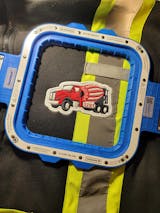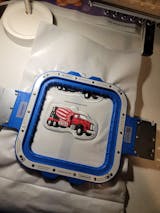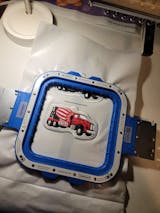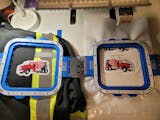1. Introduction: Unlocking the Potential of Stretch Fabric Thread
When it comes to sewing stretch fabrics, thread selection is more than a detail—it’s the backbone of every successful project. Have you ever finished a pair of leggings, only to watch the seams pop the first time you stretch them? Or maybe your carefully sewn t-shirt puckered at the shoulders, ruining that professional finish you worked so hard to achieve. These common frustrations often boil down to one thing: using the wrong thread or sewing technique.
This guide is your roadmap to mastering stretch fabric thread. We’ll explore how to choose the best threads for every project—from polyester to specialty stretch threads—so your seams stay strong and flexible. You’ll discover proven sewing techniques, machine settings, and troubleshooting tips that prevent breakage and puckering. We’ll compare thread options for activewear versus everyday garments, dive into creative uses for stretch thread, and review the essential tools that make sewing knits a breeze. Whether you’re an experienced stitcher or just starting out, you’ll learn how the right thread and technique can dramatically boost the longevity and professional look of your stretch fabric creations.
Table of Contents
- 1. Introduction: Unlocking the Potential of Stretch Fabric Thread
- 2. Best Thread Types for Stretch Fabrics: Materials and Performance
- 3. Sewing Techniques and Machine Settings for Flawless Results
- 4. Troubleshooting Common Stretch Thread Issues
- 5. Thread Applications: From Activewear to Creative Projects
- 6. Essential Tools Comparison: Enhancing Your Workflow
- 7. Conclusion: Key Takeaways for Professional Results
- 8. FAQ: Stretch Thread Essentials
2. Best Thread Types for Stretch Fabrics: Materials and Performance
Choosing the right thread for stretch fabrics isn’t just about matching color—it’s about ensuring your seams can move, flex, and last. Let’s break down the top contenders and what makes each one shine.
2.1 Polyester Thread: The Versatile Workhorse
Polyester thread is the unsung hero of stretch fabric sewing. With an elongation of around 26%, it’s engineered to flex with your fabric, making it ideal for everyday garments like t-shirts, leggings, and dresses. Unlike natural fibers, polyester boasts superior resistance to mildew, aging, and abrasion. Its smooth, glossy finish means it glides through a wide range of fabric weights without shrinking or losing shape.
But what about durability? Polyester thread consistently outperforms cotton and silk in strength, holding up through repeated stretching and washing. This makes it a go-to for projects that demand both longevity and elasticity. Its cost-effectiveness is another plus—polyester provides reliable performance without breaking the bank, making it a staple for both hobbyists and professional garment makers.
However, polyester’s slightly abrasive texture means it’s best reserved for sturdy stretch fabrics rather than delicate knits. Always test on a scrap to ensure it’s the right fit for your project.
2.2 Specialty Stretch Threads: Wooly Nylon and Beyond
When you need seams that stretch as far as your fabric—and then some—specialty threads like wooly nylon are your secret weapon. Wooly nylon is prized for its exceptional elasticity and soft, fluffy texture, making it a favorite for activewear, swimwear, and lingerie. Its unique texturized construction allows it to expand and recover with every movement, reducing the risk of seam failure in high-stress areas.
Wooly nylon isn’t just about stretch—it’s also about comfort. Its softness makes it ideal for garments worn close to the skin, and it stands up to repeated washing without losing its spring. For heavier knits, a variant like Wooly Nylon Extra offers more loft and coverage.
Budget-conscious sewists often turn to Maxi-Lock Stretch, which delivers substantial elasticity at a fraction of the cost of premium wooly nylon. While not quite as stretchy, it’s a practical choice for large-scale production where cost and performance must balance.
Application matters, too: use stretch thread in the bobbin for topstitching, or in the loopers on a serger or coverstitch machine for maximum flexibility. Always adjust your tension and test on scraps—stretch threads demand fine-tuning to avoid loose seams or tunneling.
Elastane and spandex threads take things a step further, adding dedicated stretch for garments that need to move with the body, like dancewear or athletic gear. Serger-specific threads are also optimized for overlock machines, providing clean, flexible edges on knits.
2.3 Eco-Friendly Alternatives: Sustainable Stretch Solutions
Sustainability is no longer a trend—it’s a must. Luckily, eco-friendly thread options for stretch fabrics are on the rise. Recycled polyester threads, made from repurposed plastic bottles, offer the same strength and durability as their virgin counterparts while reducing environmental impact. Organic cotton thread is another green choice, produced without harmful chemicals and perfect for all-natural projects. However, keep in mind that organic cotton offers less stretch than synthetic options, so it’s best for projects where flexibility isn’t the top priority.
Performance data on threads like ECO100 show that recycled options can match the strength and elongation of traditional polyester, making them viable for a wide range of applications. Look for Oeko-Tex certifications to ensure your thread meets strict environmental and safety standards.
In summary, the best thread for your stretch fabric project depends on your specific needs: polyester for everyday durability, wooly nylon for high-stretch performance, and recycled options for eco-conscious sewing. Test, compare, and choose the thread that gives your seams both strength and flexibility—your garments (and the planet) will thank you.
3. Sewing Techniques and Machine Settings for Flawless Results
The right thread is only half the battle—mastering your machine settings and sewing techniques is what brings your stretch fabric projects to life. Here’s how to get those seams as flexible and professional as your favorite store-bought activewear.
3.1 Stitch Selection: Zigzag vs. Stretch Stitches
Let’s start with the basics: the zigzag stitch is your best friend for sewing stretch fabrics on a regular machine. Set your stitch length to 2.5–3mm and width to 2 for a seam that flexes with your fabric but stays secure. This setup prevents thread breakage when the fabric stretches, and the seam remains nearly invisible on the right side.
For even more durability, try the triple stretch stitch—its multiple forward and backward passes make it ideal for high-stress areas. Many modern machines also offer built-in stretch or lightning bolt stitches, which are designed to handle the demands of super-stretchy knits.
If you’re hemming, a twin needle creates two parallel rows of straight stitches on top and a zigzag underneath, giving you that polished, ready-to-wear finish with plenty of give.
Sergers (overlock machines) take things up a notch, automatically adjusting the differential feed to prevent stretching or puckering as you sew. Their overlock stitches are perfect for finishing edges and constructing seams that need to withstand serious movement.
3.2 Needle and Tension Mastery
The right needle is crucial. Ballpoint needles are designed to slip between fabric fibers rather than piercing them, preventing snags and runs. For highly elastic fabrics—think swimwear or spandex—stretch needles are even better. Their deeper scarf and narrower eye help prevent skipped stitches by ensuring perfect hook timing, even when the fabric is under tension.
Needle size matters, too: use 75/11 or 90/14 for stretch needles, and match the size to your fabric weight and thread thickness.
Tension can make or break your project. Aim for a setting between 3 and 4, and always test on scraps before committing to your garment. Too tight, and you’ll get puckering; too loose, and your seams may unravel. Adjust stitch length to 2.5–3mm for most stretch applications—this allows the seam to flex without sacrificing strength.
3.3 Stabilizing Stretch Fabrics for Professional Finishes
Even the best thread and stitch can’t save you from fabric shifting or distortion. That’s where the right tools come in. A walking foot (also called an even feed foot) helps feed both layers of fabric evenly, preventing stretching or bunching as you sew. Teflon feet are another great option, especially for slippery or sticky knits—they reduce friction and keep your fabric moving smoothly.
For those battling fabric movement, solutions like the hoopmaster hooping station and Sewtalent magnetic hoops offer game-changing stabilization. These hoops hold your fabric firmly in place, minimizing shifting and ensuring even tension throughout your project. The result? Crisp, professional seams and a frustration-free sewing experience—especially when working with tricky stretch fabrics.
Remember: always support your fabric as you sew, avoid pulling or pushing, and test your setup on scraps before starting your main project. With the right combination of thread, needle, stitch, and stabilizing tools, you’ll achieve stretch seams that look—and perform—like they came straight from a high-end boutique.
Ready to put these tips into action? The next sections will guide you through troubleshooting, creative applications, and advanced techniques to take your stretch fabric sewing to the next level.
4. Troubleshooting Common Stretch Thread Issues
Stretch fabrics are notorious for their quirks—thread breakage, seam puckering, and skipped stitches can turn your dream project into a lesson in frustration. But don’t worry: with the right strategies and a little detective work, you can outsmart these common pitfalls and achieve seams that are as resilient and smooth as your favorite yoga pants.
4.1 Preventing Thread Breakage and Puckering
Let’s start with the basics: why do threads snap or seams pucker when sewing stretch fabrics? The answer lies in the delicate dance between thread, needle, fabric, and machine settings.
Thread Testing Methods:
Before you commit to a full project, always test your thread on fabric scraps. Start with a simple stretch test: gently pull the thread to check its elasticity. A good stretch thread, like polyester or texturized nylon, should stretch and recover without snapping. Visually inspect for any fuzziness, uneven thickness, or weak spots that could spell trouble down the line.
Material Matters:
Polyester thread is usually your best bet for stretch fabrics, thanks to its elasticity and moisture resistance. Texturized polyester or nylon threads take things up a notch, especially for activewear, offering even greater elongation and ply security. Avoid cotton thread—it lacks the necessary give and tends to break under tension, leading to premature seam failure.
Needle Know-How:
Ballpoint and stretch needles are your allies here. Their rounded tips part the fabric fibers instead of piercing them, preventing snags and runs. For lightweight to medium-weight knits, a ballpoint or jersey needle keeps yarn displacement (a major culprit behind puckering) at bay.
Root Causes of Puckering:
Seam puckering can sneak in from several directions:
- Yarn Displacement: Oversized thread relative to fabric weight creates bulk and distortion.
- Tension Puckering: Excessive thread tension pulls the fabric, scrunching up your seams.
- Feed Puckering: Improper fabric handling—like pulling or stretching as you sew—distorts the natural drape.
Prevention Tactics:
- Thread Size: Use the smallest thread that still provides adequate strength.
- Stitch Length: On curved seams, a slightly longer stitch helps reduce puckering.
- Fabric Handling: Guide, don’t pull. Let the feed dogs and presser foot do the work, maintaining the fabric’s natural shape.
- Compatibility: Avoid mixing polyester thread with cotton fabric for high-stretch applications; the mismatch in elasticity can cause breakage or unsightly seams.
Professional Testing Protocols:
Before you go into production mode, create sample swatches that mirror your real project—same fabric, thread, needle, and stitch settings. Test for seam strength, elongation, and appearance after stretching and laundering. This side-by-side comparison helps you spot the winning combination and avoid costly mistakes.
4.2 Advanced Solutions for Extreme Fabrics
When you’re working with the wildest of stretch fabrics—think swimwear, dancewear, or anything with serious spandex—troubleshooting moves into expert territory.
Bobbin Tension Adjustments:
High-elasticity fabrics often need a lighter bobbin tension. If your stitches are skipping or the thread keeps breaking, try loosening the bobbin tension just a touch. Always test on scraps before sewing your actual garment.
Tissue Stabilization:
For ultra-slippery or ultra-stretchy knits, place a strip of tissue paper under the fabric as you sew. This helps stabilize the fabric, prevents it from getting sucked into the needle plate, and ensures even feeding. Once you’re done, the tissue tears away easily.
Skipped Stitches:
Skipped stitches can drive anyone mad. Here’s how to fight back:
- Check Your Needle: Make sure you’re using a fresh stretch or ballpoint needle. Dull or bent needles are a common culprit.
- Slow Down: High speeds can cause the needle to miss loops, especially on elastic fabrics. Take it slow and steady.
- Adjust Tension: If you’re still seeing gaps, try lowering your upper thread tension slightly.
- Machine Settings: Use a zigzag or stretch stitch rather than a straight stitch, which can’t flex with the fabric and is prone to skipping.
Real-World Fixes from the Pros:
YouTube tutorials and expert blogs agree: patience and practice are your best friends. Don’t hesitate to experiment with different needle types, tension settings, and even presser foot pressure until you find the sweet spot for your fabric.
By systematically testing your materials, fine-tuning your machine, and mastering a few pro tricks, you’ll transform stretch fabric headaches into smooth, lasting seams—no more popped threads or puckered edges.
5. Thread Applications: From Activewear to Creative Projects
Stretch thread isn’t just a technical upgrade—it’s the secret ingredient behind everything from high-performance leggings to quirky DIY accessories. Let’s explore how this versatile thread powers both professional and creative projects.
5.1 Performance Garments: Activewear and Swimwear
When it comes to garments that move with you—think yoga pants, swimsuits, and compression tops—thread choice is mission-critical.
Wooly Nylon vs. Polyester:
Wooly nylon is the go-to for activewear and swimwear, thanks to its remarkable stretch and soft texture. It can elongate up to several times its original length, making it perfect for seams that need to flex with every squat, stretch, or dive. Polyester thread, while strong and resilient, is better suited for casual wear where extreme stretch isn’t as crucial.
Case Study: Leggings Construction
Professional leggings often combine wooly nylon in the loopers of a serger or coverstitch machine with polyester in the needle. This combo delivers seams that are both strong and flexible, resisting breakage even during intense movement. The result? Garments that hold their shape, wash after wash, and never let you down mid-workout.
Technical Edge:
The elasticity of spandex and elastane-based threads—sometimes stretching 300–600% before breaking—means your seams will outlast even the toughest workout. Always test your thread and stitch setup on scraps to ensure your finished garment has the stretch and recovery you need.
5.2 Repairs and DIY Accessories
Stretch thread isn’t just for new creations—it’s a lifesaver for repairs and inventive projects.
Repairs:
Got a popped seam on your favorite stretch pants? Swap out your regular thread for stretch thread, and those repaired seams will flex with the fabric instead of snapping again. Use the same thread in both the needle and bobbin for maximum resilience.
Hemming and Headbands:
Twin needles are a game-changer for hemming knits. They create parallel rows of stitches on the outside and a zigzag underneath, giving you a stretchy, professional-looking hem that won’t pop. For DIY headbands or scrunchies, stretch thread ensures your creations stay comfy and keep their shape, no matter how many times they’re pulled on and off.
Pro Tip from the Pros:
When sewing with stretch thread, treat it like regular thread but avoid adding extra tension when winding the bobbin. Let your machine do the work, and always test your setup on scraps before tackling the real thing.
5.3 Efficiency in Garment Production
In high-volume production, every second counts—and that’s where the right tools can transform your workflow.
Sewtalent Magnetic Hoops:
Sewtalent magnetic hoops and other embroidery hoops and frames are game-changers for mass garment production. By holding fabric securely and evenly, they slash hooping time by up to 90%. That means what used to take three minutes per garment now takes just thirty seconds—a massive boost in productivity for factories and busy studios alike.
Not only do these hoops speed up the process, but they also reduce operator fatigue and minimize errors caused by fabric shifting. The result? More garments finished in less time, with fewer defects and a more professional finish.
Whether you’re sewing one-of-a-kind accessories or running a production line, combining stretch thread with the right tools and techniques ensures your projects are both efficient and built to last.
6. Essential Tools Comparison: Enhancing Your Workflow
The unsung heroes of stretch sewing aren’t just threads and needles—they’re the tools that keep your fabric moving smoothly and your stitches looking flawless. Let’s break down the must-have accessories that make sewing stretch fabrics a breeze.
Walking Feet: A walking foot (or even feed foot) is a game-changer for stretch fabrics. Its dual-feed mechanism moves both the top and bottom layers of fabric together, preventing shifting, stretching, or bunching as you sew. This is especially important for knits and high-elasticity materials, where uneven feeding can cause ripples or misaligned seams.
Teflon Feet: Teflon feet are coated with a non-stick surface, making them perfect for sticky or high-friction fabrics like vinyl, faux leather, or certain synthetics. They glide smoothly over tricky surfaces, keeping your stitches even and your fabric undistorted. Bernina, for example, offers a range of Teflon feet tailored for everything from zigzag to precision work.
Roller Feet: For fabrics with a lot of nap or surface texture—think velvet or heavy knits—roller feet use rolling contact to reduce friction, helping your fabric feed evenly without dragging or stretching.
Choosing the Right Tool:
- Walking feet are best for maintaining alignment and preventing layer shifting in stretchy knits.
- Teflon feet excel when working with sticky or synthetic stretch fabrics.
- Roller feet shine with textured or high-friction materials.
Integration with Stretch Thread: Pairing these feet with stretch thread and the right needle creates a balanced system that preserves fabric stretch while ensuring strong, even seams. Don’t forget to adjust your thread tension and replace needles regularly for best results.
Sewtalent Compatibility: For industrial-scale operations, large embroidery hoops like Sewtalent are compatible with a wide range of machines, streamlining workflow and ensuring consistent, high-quality results across large production runs.
By investing in these essential tools and understanding how they interact with stretch threads and fabrics, you’ll elevate your sewing game—achieving professional, frustration-free results on every project.
7. Conclusion: Key Takeaways for Professional Results
Mastering stretch fabric thread is all about making smart choices—selecting the right thread, dialing in your tension, and using proven troubleshooting techniques. Remember, polyester and specialty stretch threads like wooly nylon offer the best blend of durability and flexibility for most projects. Pair them with a ballpoint or stretch needle, and always test your stitch settings on scraps before diving into your main project. Fine-tuning your tension and stitch type prevents common issues like breakage and puckering, saving you time and fabric waste. Ultimately, the secret to professional results is a willingness to experiment, test, and adjust until you find your perfect combination. So grab those scraps, run your tests, and let your creativity stretch as far as your seams will go!







